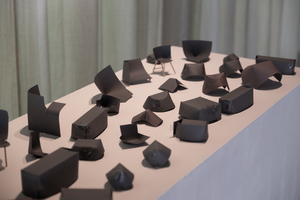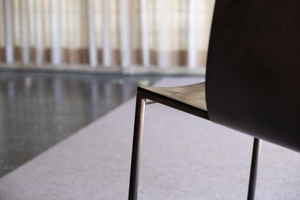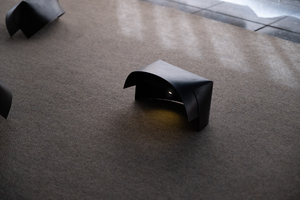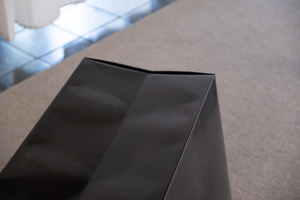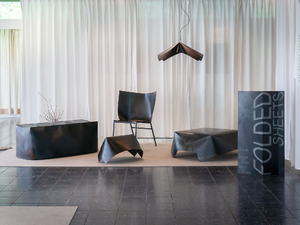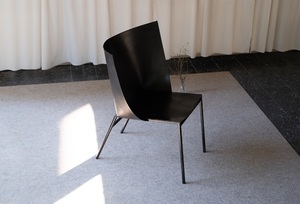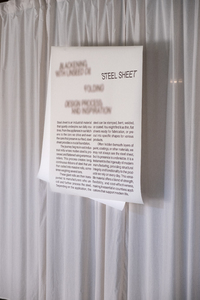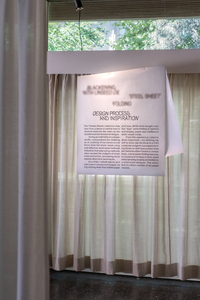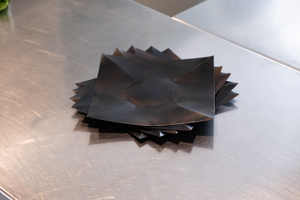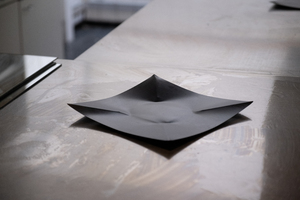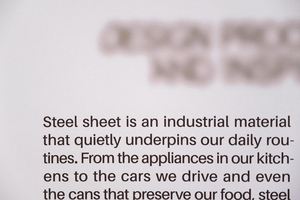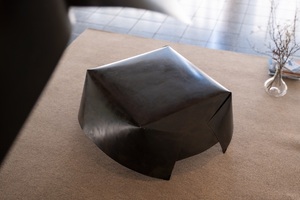HfG
Alle Inhalte mit Metadaten des Vokabulars "HfG". Sie sehen nur Inhalte, für die Sie berechtigt sind.
2622 Inhalte
- Seite 1 von 219
Folded Sheets/ Paper Models
- Titel
- Folded Sheets/ Paper Models
- Autor/in
- Datierung
- 2025
- Titel
- Folded Sheets/ Paper Models
- Urheberrechtshinweis
- © John Weber
- Freigabe Nutzung HfG
- Medienersteller/in
- Beziehung/Funktion
- Medien-Beschreibung
- Schon als Kind habe ich Flugzeuge und Autos aus Filmen nachgebaut – nur mit gefaltetem Papier und Klebeband. Anders als bei gekauftem Spielzeug wie LEGO bot mir Papier die grenzenlose Freiheit, jede erdenkliche Form zu erschaffen.
Aus dieser Erfahrung schöpfte ich meine Inspiration: Statt mich darauf zu beschränken, was in einem CAD-Programm möglich ist, experimentierte ich haptisch mit dem Materialverhalten von gefaltetem Papier. Um auf schwere Industriemaschinen zur Stahlverformung verzichten zu können, erforschte ich diverse Falttechniken. Mein Ziel war die Entwicklung einer „Falt-Sprache“, die sich auf Stahl übertragen lässt und ein intuitives, effizientes Arbeiten ermöglicht.
Nach zahlreichen Formtests fokussierte ich mich auf die vielversprechendsten Ansätze und verfeinerte diese anhand von Modellen im Maßstab 1:10, um die Konstruktionen im Detail zu verstehen und zu optimieren.
Durch die ausschließliche Verwendung rechteckiger Bleche konnte ich den Materialverschnitt reduzieren und die Recyclingfähigkeit verbessern. Oft entstehen gerade durch Faltungen und Biegungen überraschend feste und stabile Objekte.
- Schon als Kind habe ich Flugzeuge und Autos aus Filmen nachgebaut – nur mit gefaltetem Papier und Klebeband. Anders als bei gekauftem Spielzeug wie LEGO bot mir Papier die grenzenlose Freiheit, jede erdenkliche Form zu erschaffen.
- Medien-Beschreibung (en)
- As a child, I rebuilt planes and cars I saw in movies using just folded paper and tape. Unlike store-bought toys like LEGO, paper gave me endless freedom to create any shape I imagined.
From this experience, I tried to draw inspiration—not limiting myself to what can be done in aCAD computer program but experimenting hands-on with how a sheet of paper behaves whenfolded in various ways.
To avoid using heavy industrial machines to form steel sheets, I explored different paper-folding techniques. My goal was to develop a kind of folding language I could later apply to steel, allowing me to work intuitively and efficiently.
After testing many shapes, I focused on a few that worked well and refined them further, building 1:10 scale models to better understand and improve the designs.
By using only rectangular sheets, I could reduce material waste and improve recyclability. Folded and bent shapes often result in surprisingly strong and stable objects.
- As a child, I rebuilt planes and cars I saw in movies using just folded paper and tape. Unlike store-bought toys like LEGO, paper gave me endless freedom to create any shape I imagined.
- Projektleiter/in
- Studiengang
- Typ der Abschlussarbeit
- Importiert am
- 15.07.2025
- Übergeordnete Sets
- 1
Folded Sheets/ Chair
- Titel
- Folded Sheets/ Chair
- Autor/in
- Schlagworte
- Datierung
- 2025
- Titel
- Folded Sheets/ Chair
- Urheberrechtshinweis
- © John Weber
- Rechtsschutz/Lizenz
- Freigabe Nutzung HfG
- Medienersteller/in
- Medien-Beschreibung (en)
- The folded Chair from my Diploma collection ”Folded Sheets“ uses a rectangular steel
sheet to create a comfortable chair shell. The sheet it cut and folded to wrap around the
frame and create a round shell like shape under tension. This tension makes for a comfort-
able round shape that slightly leans back as you press your back into it. The shell and the
frame hold together by tension. No screws used, only the tension of the steel sheet.
- The folded Chair from my Diploma collection ”Folded Sheets“ uses a rectangular steel
- Projektleiter/in
- Studiengang
- Typ der Abschlussarbeit
- Importiert am
- 15.07.2025
- Übergeordnete Sets
- 1
Folded Sheets/ Shell
- Titel
- Folded Sheets/ Shell
- Autor/in
- Schlagworte
- Datierung
- 2025
- Titel
- Folded Sheets/ Shell
- Urheberrechtshinweis
- © John Weber
- Rechtsschutz/Lizenz
- Freigabe Nutzung HfG
- Medienersteller/in
- Projektleiter/in
- Studiengang
- Typ der Abschlussarbeit
- Importiert am
- 15.07.2025
- Übergeordnete Sets
- 1
Folded Sheets/ Bench
- Titel
- Folded Sheets/ Bench
- Autor/in
- Schlagworte
- Datierung
- 2025
- Titel
- Folded Sheets/ Bench
- Urheberrechtshinweis
- © John Weber
- Rechtsschutz/Lizenz
- Freigabe Nutzung HfG
- Medienersteller/in
- Medien-Beschreibung
- Die Bank vereint zwei verschiedene Falttechniken der Stahlblechbearbeitung. Die Sitzfläche wird durch zweidimensionale Kanten geformt. Der untere Teil zur übereinandergeschobene Flächen. Dadurch läuft die rechteckige Sitzfläche zu einer Ovalen Form richtung Boden.
Ein zentraler Falz in der Sitzfläche erhöht die Stabilität und dient beidseitig als Wasserablauf. Durch die gewölbte Form liegt die Bank nur an den beiden Außenseiten auf, während sich die Vorder- und Rückseite elegant nach oben neigen. Dies verleiht der gesamten Struktur eine leichte, dynamische Form und verbindet Funktionalität mit Ästhetik.
- Die Bank vereint zwei verschiedene Falttechniken der Stahlblechbearbeitung. Die Sitzfläche wird durch zweidimensionale Kanten geformt. Der untere Teil zur übereinandergeschobene Flächen. Dadurch läuft die rechteckige Sitzfläche zu einer Ovalen Form richtung Boden.
- Medien-Beschreibung (en)
- The bench is a blend of two steel sheet folding techniques. The top surface is expertly brake-formed, creating three distinct folds that not only ensure a comfortable seating area but also allow the rectangular seating surface to curve gracefully towards the ground. This design is further enhanced by a strategic cut and slide method, which introduces tension to the bench's feet and contributes to its rounded base.
A central crease in the seating surface adds stability and serves as a water drainage channel on both sides. The rounded shape allows the bench to rest on the ground only at its two sides, with the front and back elegantly curving upwards. This design lends the entire structure a lighter, more dynamic feel, making it both functional and aesthetically pleasing.
- The bench is a blend of two steel sheet folding techniques. The top surface is expertly brake-formed, creating three distinct folds that not only ensure a comfortable seating area but also allow the rectangular seating surface to curve gracefully towards the ground. This design is further enhanced by a strategic cut and slide method, which introduces tension to the bench's feet and contributes to its rounded base.
- Projektleiter/in
- Studiengang
- Typ der Abschlussarbeit
- Importiert am
- 15.07.2025
- Übergeordnete Sets
- 1
Folded Sheets
- Titel
- Folded Sheets
- Autor/in
- Schlagworte
- Datierung
- 2025
- Titel
- Folded Sheets
- Urheberrechtshinweis
- © John Weber
- Rechtsschutz/Lizenz
- Freigabe Nutzung HfG
- Medienersteller/in
- Projektleiter/in
- Studiengang
- Typ der Abschlussarbeit
- Importiert am
- 15.07.2025
- Übergeordnete Sets
- 1
Folded Sheets/ Chair
- Titel
- Folded Sheets/ Chair
- Autor/in
- Schlagworte
- Datierung
- 2025
- Titel
- Folded Sheets/ Chair
- Urheberrechtshinweis
- © John Weber
- Rechtsschutz/Lizenz
- Freigabe Nutzung HfG
- Medienersteller/in
- Medien-Beschreibung
- Der ‚Folded Chair‘ aus meiner Diplomkollektion ‚Folded Sheets‘ verwendet ein rechteckiges Stahlblech, um eine komfortable Sitzschale zu formen. Das Blech ist so zugeschnitten und gefaltet, dass es das Gestell umschließt und eine runde, schalenartige Form unter Spannung bildet. Diese Spannung sorgt für eine bequeme Rundung, die leicht nachgibt, sobald man sich anlehnt. Schale und Rahmen werden allein durch Spannung zusammengehalten. Es kommen keine Schrauben zum Einsatz, lediglich die Eigenspannung des Stahlblechs.
- Medien-Beschreibung (en)
- The folded Chair from my Diploma collection ”Folded Sheets“ uses a rectangular steel
sheet to create a comfortable chair shell. The sheet it cut and folded to wrap around the
frame and create a round shell like shape under tension. This tension makes for a comfort-
able round shape that slightly leans back as you press your back into it. The shell and the
frame hold together by tension. No screws used, only the tension of the steel sheet.
- The folded Chair from my Diploma collection ”Folded Sheets“ uses a rectangular steel
- Projektleiter/in
- Studiengang
- Typ der Abschlussarbeit
- Importiert am
- 15.07.2025
- Übergeordnete Sets
- 1
Folded Sheets/ Infopanels
- Titel
- Folded Sheets/ Infopanels
- Autor/in
- Schlagworte
- Datierung
- 2025
- Titel
- Folded Sheets/ Infopanels
- Urheberrechtshinweis
- © John Weber
- Rechtsschutz/Lizenz
- Freigabe Nutzung HfG
- Medienersteller/in
- Medien-Beschreibung
- Das Narrativ der Ausstellung wurde auf drei Informationstafeln aus gefaltetem Papier präsentiert. Das Papier wurde dabei über ein dünnes Seil gefaltet
- Medien-Beschreibung (en)
- The narrative of this exhibition was displayed on three folded paper info panels. Paper was folded on a thin rope.
- The narrative of this exhibition was displayed on three folded paper info panels. Paper was folded on a thin rope.
- Projektleiter/in
- Studiengang
- Typ der Abschlussarbeit
- Importiert am
- 15.07.2025
- Übergeordnete Sets
- 1
Folded Sheets/ Infopanels
- Titel
- Folded Sheets/ Infopanels
- Autor/in
- Schlagworte
- Datierung
- 2025
- Titel
- Folded Sheets/ Infopanels
- Urheberrechtshinweis
- © John Weber
- Rechtsschutz/Lizenz
- Freigabe Nutzung HfG
- Medienersteller/in
- Medien-Beschreibung
- Das Narrativ der Ausstellung wurde auf drei Informationstafeln aus gefaltetem Papier präsentiert. Das Papier wurde dabei über ein dünnes Seil gefaltet
- Medien-Beschreibung (en)
- The narrative of this exhibition was displayed on three folded paper info panels. Paper was folded on a thin rope.
- The narrative of this exhibition was displayed on three folded paper info panels. Paper was folded on a thin rope.
- Projektleiter/in
- Studiengang
- Typ der Abschlussarbeit
- Importiert am
- 15.07.2025
- Übergeordnete Sets
- 1
Folded Sheets/ Plates
- Titel
- Folded Sheets/ Plates
- Autor/in
- Schlagworte
- Datierung
- 2025
- Titel
- Folded Sheets/ Plates
- Urheberrechtshinweis
- © John Weber
- Rechtsschutz/Lizenz
- Freigabe Nutzung HfG
- Medienersteller/in
- Medien-Beschreibung
- Der sogenannte ‚Frosch‘ ist ein Phänomen in der Blechbearbeitung, bei dem durch Verformung Spannung im Material aufgebaut wird. Wirkt man dieser Spannung mit Kraft entgegen, springt das Blech mit einem hörbaren Knacken in die entgegengesetzte Form um. Die Teller-Serie macht sich diesen Effekt zunutze, um eine konkave Wölbung zu erzeugen, die als Teller oder Schale dient.
- Medien-Beschreibung (en)
- The "Frosch" is a phenomenon in sheet metal processing where tension is created in the material through deformation. By applying force against this tension, the sheet metal "springs" back with an audible snap into an opposite shape. The plate series utilizes this effect to create a concave form that serves as a plate or bowl.
- Projektleiter/in
- Studiengang
- Typ der Abschlussarbeit
- Importiert am
- 15.07.2025
- Übergeordnete Sets
- 1
Folded Sheets/ Plates
- Titel
- Folded Sheets/ Plates
- Autor/in
- Schlagworte
- Datierung
- 2025
- Titel
- Folded Sheets/ Plates
- Urheberrechtshinweis
- © John Weber
- Rechtsschutz/Lizenz
- Freigabe Nutzung HfG
- Medienersteller/in
- Medien-Beschreibung
- Der sogenannte ‚Frosch‘ ist ein Phänomen in der Blechbearbeitung, bei dem durch Verformung Spannung im Material aufgebaut wird. Wirkt man dieser Spannung mit Kraft entgegen, springt das Blech mit einem hörbaren Knacken in die entgegengesetzte Form um. Die Teller-Serie macht sich diesen Effekt zunutze, um eine konkave Wölbung zu erzeugen, die als Teller oder Schale dient.
- Medien-Beschreibung (en)
- The "Frosch" is a phenomenon in sheet metal processing where tension is created in the material through deformation. By applying force against this tension, the sheet metal "springs" back with an audible snap into an opposite shape. The plate series utilizes this effect to create a concave form that serves as a plate or bowl.
- Projektleiter/in
- Studiengang
- Typ der Abschlussarbeit
- Importiert am
- 15.07.2025
- Übergeordnete Sets
- 1
Folded Sheets/ Infopanels
- Titel
- Folded Sheets/ Infopanels
- Autor/in
- Schlagworte
- Datierung
- 2025
- Titel
- Folded Sheets/ Infopanels
- Urheberrechtshinweis
- © John Weber
- Rechtsschutz/Lizenz
- Freigabe Nutzung HfG
- Medienersteller/in
- Medien-Beschreibung
- Das Narrativ der Ausstellung wurde auf drei Informationstafeln aus gefaltetem Papier präsentiert. Das Papier wurde dabei über ein dünnes Seil gefaltet
- Medien-Beschreibung (en)
- The narrative of this exhibition was displayed on three folded paper info panels. Paper was folded on a thin rope.
- The narrative of this exhibition was displayed on three folded paper info panels. Paper was folded on a thin rope.
- Projektleiter/in
- Studiengang
- Typ der Abschlussarbeit
- Importiert am
- 15.07.2025
- Übergeordnete Sets
- 1
Folded Sheets/ Coffee Table
- Titel
- Folded Sheets/ Coffee Table
- Autor/in
- Schlagworte
- Datierung
- 2025
- Titel
- Folded Sheets/ Coffee Table
- Urheberrechtshinweis
- © John Weber
- Rechtsschutz/Lizenz
- Freigabe Nutzung HfG
- Medienersteller/in
- Medien-Beschreibung
- Der Couchtisch veranschaulicht die Technik von ‚Shell‘ in einem größeren Maßstab. Vier Faltungen bilden die Standfüße. Gleichzeitig erzeugen diese Faltungen eine flache, unter Spannung stehende Tischfläche.
- Medien-Beschreibung (en)
- The coffee table visualizes the technique from “Shell” in a bigger scale. Four folds create feet for the table to stand on. The folds also create a flat tensioned plane on top.
- Projektleiter/in
- Studiengang
- Typ der Abschlussarbeit
- Importiert am
- 15.07.2025
- Übergeordnete Sets
- 1
